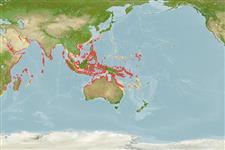>
Eupercaria/misc (Various families in series Eupercaria) >
Labridae (Wrasses) > Corinae
Etymology: Halichoeres: Greek, als, alis = salt + Greek, choiros = pig (Ref. 45335).
More on author: Bennett.
Environment: milieu / climate zone / depth range / distribution range
Ekologi
laut berasosiasi dengan karang; kisaran kedalaman 1 - 20 m (Ref. 90102). Tropical; 32°N - 24°S
Indo-West Pacific: Red Sea and East Africa (Ref. 2334) to Papua New Guinea, north to Japan, south to the Great Barrier Reef in Australia.
Size / Weight / umur
Maturity: Lm ? range ? - ? cm
Max length : 20.0 cm TL jantan/; (Ref. 30573)
deskripsi pendek
Kunci identifiaksi (pengenalan) | Morfologi | Morfometrik
Duri punggung (Keseluruhan (total)) : 9; duri punggung lunak (Keseluruhan (total)) : 11; Duri dubur: 3; Sirip dubur lunak: 11. The initial phase is olivaceous to brownish yellow dorsally, white ventrally, with a black zigzag stripe running from eye to upper caudal peduncle (continuing anteriorly as a yellow stripe from the eye to the snout). This primary phase is similar to H. trimaculatus except for the black zigzag stripe along its back (Ref. 1602). The terminal phase is green, the zigzag stripe lavender-pink with its anterior portion overlaid by a black blotch.
Common in shallow lagoons or bays; usually over sand, rubble, or seagrass bottom (Ref. 41878), rather than on coral reefs. May be found in groups (Ref. 90102). Usually solitary and aggressive towards members of its own species. Feeds on small crustaceans by picking them off the sandy bottom (Ref. 5503).
Life cycle and mating behavior
Maturities | Reproduksi, perkembang biakan | Spawnings | Egg(s) | Fecundities | Larva
Distinct pairing during breeding (Ref. 205). Pelagic spawner (Ref. 32193).
Randall, J.E., G.R. Allen and R.C. Steene, 1990. Fishes of the Great Barrier Reef and Coral Sea. University of Hawaii Press, Honolulu, Hawaii. 506 p. (Ref. 2334)
Status IUCN Red List (Ref. 130435)
ancaman kepada manusia
Harmless
penggunaan manusia
Perikanan: nilai komersial kecil; Akuarium: Komersial
Alat, peralatan
laporan khas
muat turun XML
Sumber internet
Estimates based on models
Preferred temperature (Ref.
123201): 26.2 - 29.3, mean 28.6 °C (based on 2756 cells).
Phylogenetic diversity index (Ref.
82804): PD
50 = 0.5000 [Uniqueness, from 0.5 = low to 2.0 = high].
Bayesian length-weight: a=0.01000 (0.00574 - 0.01742), b=3.15 (3.00 - 3.30), in cm total length, based on LWR estimates for this species & Genus-body shape (Ref.
93245).
Trophic level (Ref.
69278): 3.5 ±0.50 se; based on food items.
Generation time: 1.8 ( na - na) years. Estimated as median ln(3)/K based on 1
growth studies.
Daya lenting (Ref.
120179): Tinggi, Waktu penggandaan populasi minimum kurang dari 15 bulan (K=0.6).
Fishing Vulnerability (Ref.
59153): Low vulnerability (23 of 100).
Nutrients (Ref.
124155): Calcium = 81.2 [48.7, 136.7] mg/100g; Iron = 0.733 [0.426, 1.332] mg/100g; Protein = 18.6 [15.7, 20.8] %; Omega3 = 0.147 [0.096, 0.229] g/100g; Selenium = 24 [15, 43] μg/100g; VitaminA = 108 [35, 388] μg/100g; Zinc = 1.57 [1.09, 2.43] mg/100g (wet weight);
